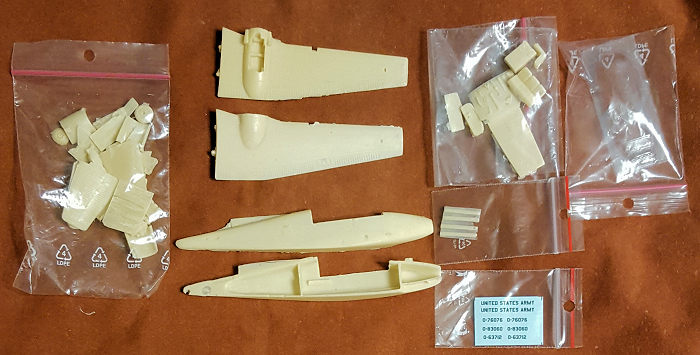
| KIT #: | ? |
| PRICE: | $ |
| DECALS: | Two options |
| REVIEWER: | Scott Van Aken |
| NOTES: | Short run resin kit |

| HISTORY |
The first L-23As entered service in 1953 and the type served the US Army for almost forty years, the last U-8Fs being retired in 1992. When US military aircraft designations were revised in 1962, the remaining L-23D, RL-23D, L-23E and L-23F aircraft became U-8Ds, RU-8Ds, U-8Es and U-8Fs. A further 47 Model 65s were ordered in 1962 and 1963 as U-8Fs; one of these was delivered to the Pakistan Army, the only delivery outside the US military (although other nations bought Queen Airs as military aircraft). These were the final new-build aircraft in the series, however the unique Beechcraft Model 87 turboprop proof-of-concept aircraft used in developing the King Air was delivered to the Army as the NU-8F in 1964 (this was later re-designated the YU-21) and a few used Queen Airs were also taken by the Army.
Many U-8Fs were modified during their service lives to a similar standard as civilian Excalibur Queen Airs. The most obvious modifications are more powerful Lycoming IO-720 eight-cylinder engines in place of the factory-fitted six-cylinder engines; and bulged main landing gear doors that fully enclose the wheels when the gear is retracted instead of the wheels partially protruding through the doors. Many L-23Ds/U-8Ds and U-8Fs have been registered as civilian aircraft since retirement from military service.
| THE KIT |
 This is
very much your standard garage kit, but without the issue of molding glitches.
That means no air bubbles or pockets, though you do have to drill out the holes
for mounting the flight surfaces. Not a big deal and standard stuff for those
who build these sorts of kits.
This is
very much your standard garage kit, but without the issue of molding glitches.
That means no air bubbles or pockets, though you do have to drill out the holes
for mounting the flight surfaces. Not a big deal and standard stuff for those
who build these sorts of kits.
The sturdy box comes with the fuselage halves and wings separate with the rest of the parts in zip bags of various sizes. All of the parts are free of any pouring stubs and only a few, like the props and landing gear, are still surrounded by the resin wafers. This helps to keep them from breaking during shipment.
The interior consists of a floor onto which the front seats are attached. Behind this is a bank of radios and a seat for the radio operator. A small shelf is also included. This will fit into the left fuselage half where there are ridges to accept them. While no indication of how much weight is needed, you will need to fit it into every available space forward of the main gear. There is a good size cavity above the nose gear well for this.
Once the fuselage halves are joined, you can attach the various flight surfaces. The instrument panel with the control wheels is then glued in place followed by the cockpit/cabin clear piece. This is a large vacuformed part that has the windows and the surrounding fuselage. Two of these are provided in case you need a second one.
Both the nose and main gear take up a goodly number of parts with each having separate oleo scissors and retraction struts. The main gear cant forward a bit which is why it is important to put in as much nose weight as you can. Engine nacelles are an upper and a lower half which are joined together. A full engine is provided which attaches to the cowling front piece and is then inserted into the cowling. The cowling is joined to the wing. If concerned about weight, you may consider removing the last four cylinders from the engine to provide space.
The last steps are adding the considerable number of antennas and vents that were standard on the ELINT version. This also includes building up the props from separate blades and a spinner and attaching the vacuformed landing light cover.
The instructions consist of a nicely done drawn page that is folded to include 14 construction steps. All the color information is in Russian, but that should not be much of an issue. Basically, the outside is olive drab with the interior in dark grey. There is a nicely restored plane at the Combat Air Museum and here is a link. It includes interior photos: http://www.combatairmuseum.org/aircraft/beechbonanza.html . These aircraft were minimally marked and you are provided serial numbers for three planes on the small sheet.
| CONCLUSIONS |
The only way to get interesting kits like this is with resin as the major kits makers won't touch them. This one has several benefits. One is that it could easily be built as a civilian Twin Bonanza. Another is you can do a standard L-23/U-8, only requiring decals and since most of the military markings are pretty standard stuff, that should not be a problem. With all the antennas this one has, the last steps will probably prove to be rather fiddly, but anyone with experience in building resin kits will not have any problems.
| REFERENCES |
https://en.wikipedia.org/wiki/Beechcraft_L-23_Seminole
July 2018
Copyright ModelingMadness.com. All rights reserved.
Thanks to Croco
for the review kit. Contact the owner at
sniff23@inbox.lv
for more information on getting yours.
If you would like your product reviewed fairly and
fairly quickly, please
contact
the editor or see other details in the
Note to
Contributors. Back to the Main Page
Back to the Review
Index Page
Back to the Previews Index Page